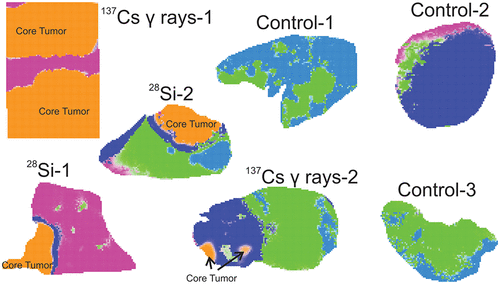Our official English website, www.x-mol.net, welcomes your
feedback! (Note: you will need to create a separate account there.)
137Cs γ Ray and 28Si Irradiation Induced Murine Hepatocellular Carcinoma Lipid Changes in Liver Assessed by MALDI-MSI Combined with Spatial Shrunken Centroid Clustering Algorithm: A Pilot Study
ACS Omega ( IF 3.7 ) Pub Date : 2020-09-22 , DOI: 10.1021/acsomega.0c03047 Anna M. Nia 1 , Alexander Shavkunov 2 , Robert L. Ullrich 3 , Mark R. Emmett 1, 2, 4
ACS Omega ( IF 3.7 ) Pub Date : 2020-09-22 , DOI: 10.1021/acsomega.0c03047 Anna M. Nia 1 , Alexander Shavkunov 2 , Robert L. Ullrich 3 , Mark R. Emmett 1, 2, 4
Affiliation

|
Characterization of lipids by matrix-assisted laser desorption ionization mass spectrometry imaging (MALDI-MSI) is of great interest because not only are lipids important structural molecules in both the cell and internal organelle membranes, but they are also important signaling molecules. MALDI-MSI combined with spatial image segmentation has been previously used to identify tumor heterogeneities within tissues with distinct anatomical regions such as the brain. However, there has been no systematic study utilizing MALDI-MSI combined with spatial image segmentation to assess the tumor microenvironment in the liver. Here, we present that image segmentation can be used to evaluate the tumor microenvironment in the liver. In particular, to better understand the molecular mechanisms of irradiation-induced hepatic carcinogenesis, we used MALDI-MSI in the negative ion mode to identify lipid changes 12 months post exposure to low dose 28Si and 137Cs γ ray irradiation. We report here the changes in the lipid profiles of male C3H/HeNCrl mice liver tissues after exposure to irradiation and analyzed using the spatial shrunken centroid clustering algorithm. These findings provide valuable information as astronauts will be exposed to high-charge high-energy (HZE) particles and low-energy γ-ray irradiation during deep space travel. Even at low doses, exposure to these irradiations can lead to cancer. Previous studies infer that irradiation of mice with low-dose HZE particles induces oxidative damage and microenvironmental changes that are thought to play roles in the pathophysiology of hepatocellular carcinoma.
中文翻译:

137 Cs的γ射线和28度的Si辐射诱导的鼠肝细胞癌血脂的改变肝分摊通过MALDI-MSI结合空间皱缩质心聚类算法的初步研究
通过基质辅助激光解吸电离质谱成像(MALDI-MSI)表征脂质非常受关注,因为脂质不仅在细胞和内部细胞器膜中都是重要的结构分子,而且还是重要的信号分子。MALDI-MSI与空间图像分割相结合,以前已被用于识别具有不同解剖区域(例如大脑)的组织内的肿瘤异质性。然而,还没有系统的研究利用MALDI-MSI结合空间图像分割来评估肝脏中的肿瘤微环境。在这里,我们提出图像分割可用于评估肝脏中的肿瘤微环境。特别是为了更好地了解辐射诱发的肝癌发生的分子机制,28 Si和137 Csγ射线辐照。我们在这里报告了男性C3H / HeNCrl小鼠肝脏组织暴露于辐射后脂质谱的变化,并使用空间收缩质心聚类算法进行了分析。这些发现提供了有价值的信息,因为宇航员在深空旅行期间将暴露于高电荷高能(HZE)粒子和低能γ射线照射下。即使低剂量,暴露于这些辐射下也会导致癌症。先前的研究推断,用低剂量HZE颗粒照射小鼠会诱导氧化损伤和微环境变化,这些变化被认为在肝细胞癌的病理生理中起作用。
更新日期:2020-10-06
中文翻译:

137 Cs的γ射线和28度的Si辐射诱导的鼠肝细胞癌血脂的改变肝分摊通过MALDI-MSI结合空间皱缩质心聚类算法的初步研究
通过基质辅助激光解吸电离质谱成像(MALDI-MSI)表征脂质非常受关注,因为脂质不仅在细胞和内部细胞器膜中都是重要的结构分子,而且还是重要的信号分子。MALDI-MSI与空间图像分割相结合,以前已被用于识别具有不同解剖区域(例如大脑)的组织内的肿瘤异质性。然而,还没有系统的研究利用MALDI-MSI结合空间图像分割来评估肝脏中的肿瘤微环境。在这里,我们提出图像分割可用于评估肝脏中的肿瘤微环境。特别是为了更好地了解辐射诱发的肝癌发生的分子机制,28 Si和137 Csγ射线辐照。我们在这里报告了男性C3H / HeNCrl小鼠肝脏组织暴露于辐射后脂质谱的变化,并使用空间收缩质心聚类算法进行了分析。这些发现提供了有价值的信息,因为宇航员在深空旅行期间将暴露于高电荷高能(HZE)粒子和低能γ射线照射下。即使低剂量,暴露于这些辐射下也会导致癌症。先前的研究推断,用低剂量HZE颗粒照射小鼠会诱导氧化损伤和微环境变化,这些变化被认为在肝细胞癌的病理生理中起作用。











































 京公网安备 11010802027423号
京公网安备 11010802027423号